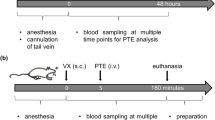Abstract
The interaction with neural neuropathy target esterase (NTE) and acetylcholinesterase (AChE) in vivo of methamidophos (O,S-dimethyl phosphorothioamidate), its resolved stereoisomers and five higher O-alkyl homologues has been examined along with the ability of these compounds to cause organophosphorus-induced delayed polyneuropathy (OPIDP) in adult hens. For the lower homologues AChE was more sensitive than NTE and it was impossible to achieve high inhibition of NTE in vivo without both prophylaxis and therapy against acute anticholinesterase effects; for then-hexyl homologue high inhibition of NTE could be achieved without obvious anticholinesterase effects and spontaneous reactivation of inhibited AChE was seen as in vitro. The maximum tolerated dose ofl(−) methamidophos or of the ethyl oriso-propyl homologues did not inhibit NTE more than 60%, and surviving birds did not develop OPIDP. Then-propyl,n-butyl andn-hexyl compounds caused typical OPIDP at doses causing a peak of 70–95% inhibition of NTE in brain, spinal cord and sciatic nerve soon after dosing. Racemic methamidophos caused unusually mild OPIDP associated with very high inhibition of NTE at doses estimated to be >8 times the unprotected LD50 and thed-(+) isomer caused OPIDP at about 5−7× LD50. Clinical effects correlated with histopathology in 19 out of 20 examined birds. In contrast to results of many previous studies with organophosphates and phosphonates, all these cases of OPIDP were associated with formation of inhibited NTE which could be reactivated ex vivo by treatment of autopsy tissue with KF solution. It is not clear whether “aging” of inhibited NTE had occurred but with less associated stabilisation of the enzyme-phosphorus bond or whether, even without aging, the unusual N-unsubstituted phosphoramidate caused sufficient disturbance in or near the NTE target to initiate the same degenerative process as that caused typically by generation of “aged” organophosphorylated NTE.
Similar content being viewed by others
Abbreviations
- OP:
-
organophosphorus
- OPIDP:
-
OP-induce delayed polyneuropathy
- NTE:
-
neuropathy target esterase, formerly known as neurotoxic esterase
- UI-NTE:
-
unmodified inhibited NTE
- MI-NTE:
-
modified (typically by “aging”) inhibited NTE
- AChE:
-
acetylcholinesterase
References
Bertolazzi M, Caroldi S, Moretto A, Lotti M (1991) Interaction of methamidophos with hen and human acetylcholinesterase and neuropathy target esterase. Arch Toxicol (in press)
Caroldi S, Lotti M (1982) Neurotoxic esterase in peripheral nerve: assay, inhibition and rate of resynthesis. Toxicol App Pharmacol 62: 498–501
Clothier B, Johnson MK (1979) Rapid aging of neurotoxic esterase after inhibition by di-isopropyl phosphorofluoridate. Biochem J 177: 549–558
Clothier B, Johnson MK (1980) Reactivation and aging of neurotoxic esterase inhibited by a variety of organophosphorus esters. Biochem J 185: 739–747
Johnson MK (1974) The primary biochemical lesion leading to the delayed neurotoxic effects of some organophosphorus esters. J Neurochem 23: 785–789
Johnson MK (1975) Organophosphorus esters causing delayed neurotoxic effects: mechanism of action and structure/activity studies. Arch Toxicol 34: 259–288
Johnson MK (1977) Improved assay of neurotoxic esterase for screening organophosphates for delayed neurotoxicity potential. Arch Toxicol 37: 113–115
Johnson MK (1978) The anomalous behaviour of some dimethyl phosphates in the biochemical test for delayed neurotoxicity potential. Arch Toxicol 41: 107–110
Johnson MK (1982) The target for initiation of delayed neurotoxicity by organophosphorus esters: biochemical studies and toxicological applications. In: Hodgson E, Bend JR, Philpot RM (eds) Rev. Biochem Toxicol Vol. 4. Elsevier, New York, pp 141 -212
Johnson MK (1987) Receptor or enzyme: the puzzle of NTE and organo-phosphate-induced delayed polyneuropathy. TIPS 8: 174–179
Johnson MK (1988) Sensitivity and selectivity of compounds interacting with neuropathy target esterase: further structure/activity studies. Biochem Pharmacol 37: 4095–4104
Johnson MK (1991) Molecular events in delayed neuropathy: experimental aspects of neuropathy target esterase. In: Ballantyne B, Marrs T (eds) Clinical and experimental toxicology of anticholinesterases. Butterworths, Guildford England (in press)
Johnson MK, Read DJ (1987) The influence of chirality on the delayed neuropathic potential of some organophosphorus esters: delayed neuropathic and protective effects respectively are caused by thel(−) andd(+) isomers of EPN and its oxon. Toxicol Appl Pharmacol 90: 103–115
Johnson MK, Read DJ, Benschop HP (1985) Interaction of the four stereoisomers of soman (pinacolyl methylphosphonofluoridate) with acetylcholinesterase and neuropathy target esterase of nenbrain. Biochem Pharmacol 34: 1945–1951
Johnson MK, Read DJ, Yoshikawa H (1986) The effect of steric factors on the interaction of some phenylphosphonates with acetylcholinesterase and neuropathy target esterase of hen brain. Pestic Biochem Physiol 25: 133–142
Johnson MK, Vilanova E, Read DJ (1989) Biochemical and clinical tests of the delayed neuropathic potential of some O-alkyl 0–2,5-dichlorophenyl analogues of methamidophos (O,S-dimethyl phosphorothioamidate). Toxicology 54: 89–100
Lotti M, Moretto A, Traverso R (1989) Serum À' esterases and organophosphates toxicity in man. In: Reiner E, Aldridge WN, Hoskin FCG (eds) Enzymes hydrolysing organophosphorus compounds. Ellis Horwood, Chichester, pp 193–201
Prentice DE, Roberts NL (1983) Acute delayed neurotoxicity in hens dosed with tri-ortho-cresyl phosphate (TOCP): correlation between clinical ataxia and neuropathological findings. Neurotoxicology 4 [2]: 271–276
Senanayake N (1985) Polyneuropathy following insecticide poisoning: a clinical and electrophysiological study. Proc XIIIth World Congress of Neurology, FRG
Senanayake N, Johnson MK (1982) Acute polyneuropathy following poisoning by a new organophosphate insecticide: a preliminary report. N Eng J Med 306: 155–156
Vilanova E, Johnson MK, Vicedo JL (1987) Interaction of some unsubstituted phosphoramidate analogues of methamidophos (O,S-dimethyl phosphorothioamidate) with acetylcholinesterase and neuropathy target esterase of hen brain. Pestic Biochem Physiol 28: 224–238
Author information
Authors and Affiliations
Rights and permissions
About this article
Cite this article
Johnson, M.K., Vilanova, E. & Read, D.J. Anomalous biochemical responses in tests of the delayed neuropathic potential of methamidophos (O,S-dimethyl phosphorothioamidate), its resolved isomers and of some higher O-alkyl homologues. Arch Toxicol 65, 618–624 (1991). https://doi.org/10.1007/BF02098026
Received:
Accepted:
Issue Date:
DOI: https://doi.org/10.1007/BF02098026




